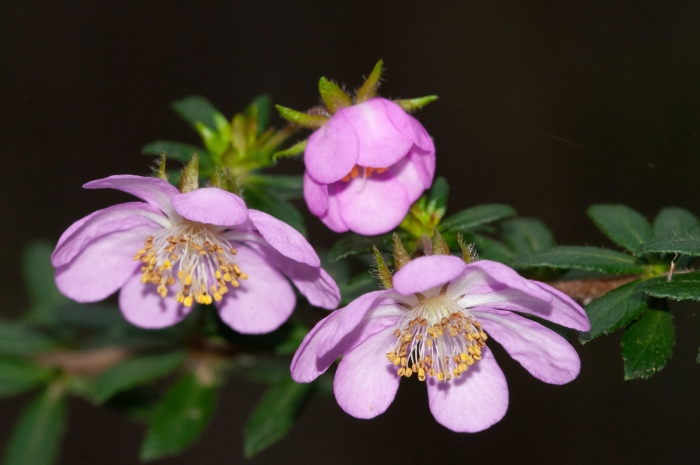River Rose
(Bauera rubioides)
River Rose (Bauera rubioides)
/
/

Rolf Lawrenz
CC BY 4.0
Image By:
Rolf Lawrenz
Recorded By:
Copyright:
CC BY 4.0
Copyright Notice:
Photo by: Rolf Lawrenz | License Type: CC BY 4.0 | License URL: http://creativecommons.org/licenses/by/4.0/ | Rights Holder: Rolf Lawrenz | Publisher: iNaturalist | Date Created: 2019-09-23T14:45:40-07:00 |






























































Estimated Native Range
Summary
Bauera rubioides, commonly known as River Rose, is an evergreen subshrub native to moist forests, stream banks, and wet heathlands in Eastern and Southeastern Australia, including Tasmania. It is a scrambling, tangled shrub that typically grows to a height of up to 2 m (6 ft 7 in) with wiry, extensively-branched stems. The leaves are trifoliate, with leaflets narrowly elliptic, mostly 3–15 mm (0.12–0.59 in) long and 1.5–5.0 mm (0.059–0.197 in) wide, usually having four to ten teeth on each edge. The flowers are showy, borne on pedicels longer than 5 mm (0.20 in), with six to eight toothed sepals 3–4 mm (0.12–0.16 in) long, six to eight usually pink, sometimes white petals 6–8 mm (0.24–0.31 in) long, and typically fifty to sixty cream-colored stamens. Flowering mostly occurs in spring and summer, adding a splash of color to the garden.
River Rose is valued for its ornamental flowers and ability to attract pollinators. It is often used in cultivation for ground cover, in mixed borders, and for erosion control due to its dense growth habit. Bauera rubioides thrives in moist, well-drained soil, preferring full sun to light shade. It is hardy and adaptable to various conditions but requires consistent moisture to flourish. While it is generally pest and disease-free, it can suffer from root rot in poorly drained soils. Propagation is readily achieved through cuttings, making it an accessible plant for gardeners.CC BY-SA 4.0
River Rose is valued for its ornamental flowers and ability to attract pollinators. It is often used in cultivation for ground cover, in mixed borders, and for erosion control due to its dense growth habit. Bauera rubioides thrives in moist, well-drained soil, preferring full sun to light shade. It is hardy and adaptable to various conditions but requires consistent moisture to flourish. While it is generally pest and disease-free, it can suffer from root rot in poorly drained soils. Propagation is readily achieved through cuttings, making it an accessible plant for gardeners.CC BY-SA 4.0
Plant Description
- Plant Type: Shrub
- Height: 3-4 feet
- Width: 5-6 feet
- Growth Rate: Moderate
- Flower Color: White, Pink, Purple
- Flowering Season: Spring, Summer
- Leaf Retention: Evergreen
Growth Requirements
- Sun: Full Sun, Part Shade
- Water: High
- Drainage: Medium, Fast
Common Uses
Bird Garden, Butterfly Garden, Groundcover, Potted Plant, Showy Flowers
Natural Habitat
native to moist forests, stream banks, and wet heathlands in Eastern and Southeastern Australia, including Tasmania
Other Names
Common Names: Dog-Rose, Wiry Bauera
Scientific Names: , Bauera rubioides, Bauera rubioides var. microphylla, Bauera rubiifolia, Bauera humilis, Bauera billardieri, Bauera rubioides var. humilis, Bauera galioides, Bauera glabriflora, Bauera humilis var. brevipedunculata
GBIF Accepted Name: Bauera rubioides Banks ex Andrews